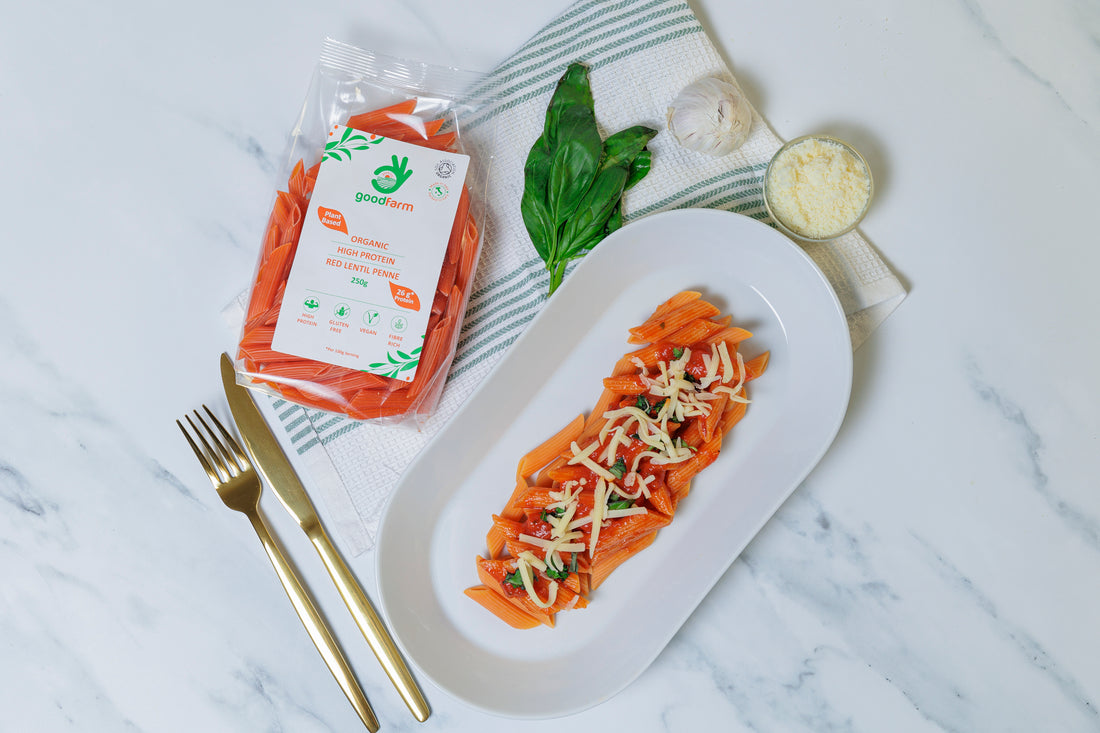
Why Choose High Protein Organic Pasta? Unveiling the Benefits for You and the Planet
Share
When choices of food affect both us and the environment, deciding on organic pasta made from green peas, chickpeas, or red lentils is not following a fad, but making a choice in lifestyle. The reason organic pasta is considered better for your health and the planet will be discussed through the lens of nutrient-dense legumes.
What is Organic High Protein Pasta?
This organic pasta is made from elements grown without synthetic pesticides, herbicides, and genetically modified organisms. Three powerhouse legumes—green peas, chickpeas, and red lentils—make up the pasta being reviewed here.
- Nutritional benefits: High in Protein: One outstanding feature of this legume-based pasta is that it is extremely rich in protein. Green peas, chickpeas, and red lentils are great plant-based protein sources, with this protein needed for many things like repairing muscles, supporting the immune system, and ensuring good health.
- Fiber-Rich: Fiber is one of the most critical elements for digestive health, and legumes are very rich in dietary fiber.
- Low Glycemic Index: Pastas made from legumes, in general, depict a low glycemic index compared to wheat pasta. This means that it gives a slow increase in blood sugar levels, which makes it excellent for diabetic patients and those who want to lose weight.
- Full of Essential Nutrients: Besides protein and fiber, these legumes are packed with different vitamins and minerals. Green peas are rich in vitamins A, C, and K, along with folate and iron. For their part, chickpeas have high contents of B vitamins, manganese, and magnesium, while red lentils are filled with potassium and zinc.
- Naturally gluten free: Red lentil pasta, green pea or chickpea pasta are all naturally gluten free with no added wheat or gluten products. This is the ideal choice for coeliacs or those opting for a low gluten diet.
Sustainable Farming Practices
Organics lean on natural processes and materials as much as possible to achieve good soil health and a cleaner environment. Here is how choosing organic pasta made from legumes contributes to sustainability:
- No use of chemicals: Organic farming does not use synthetic pesticides, herbicides, and fertilizers. This is not only good for local wildlife and ecosystems; it will also reduce the risk of hazardous chemical residues in your food.
- Soil health: Crop rotation and addition of compost to the soil are some of the organic farming practices that increase the health and fertility of soils.
- Water conservation: The general trends in organic farming usually involve the application of less water as compared to conventional practices.
- Biodiversity: Organic farming promotes biodiversity since it is associated with a wide variety of plants, animals, and insects. This ecological balance will thus prove to be potent enough to create resilient farming systems and protect natural habitat.
The Ethical Choice
Ethical point for choosing pea-based, chickpea, or red lentil pasta goes to support fair labor in the farming of such ingredients. Organic farming tends to support fair labor practices, thus ensuring the good treatment of workers and safe working conditions. By buying organic, you are also promoting a system that is caring towards animals because the standards of organic production tend to exclude factory farming and establish a more considerate attitude towards livestock.
Culinary Versatility and Flavor
Apart from health and environmental benefits, one will face exciting culinary possibilities of legume-based pasta. Here's why you might find these pastas delightful:
- Individual Flavors and Textures: Pasta made with peas, chickpeas, or red lentils will have different flavors and textures that can bring new dimensions to your meal. Chickpea pasta slightly tastes nutty, while lentil pasta is known for its rich earthy flavor.
- Good Cooking Performance: These pastas really do hold their shape during cooking and offer good al dente texture. More so, they absorb the sauces really well, hence performing across dishes wondrously. They cook quick fairly quicky too.
- Gluten-Free Option: Most of the legume-based pastas are intrinsically gluten-free, and so it creates an excellent option for those sensitive to gluten or those diagnosed with celiac disease. But always remember to check the label to assure there is no cross-contamination in case of a severe intolerance to gluten.
How to Incorporate Organic Pasta into Your Diet
Adding some organically produced pasta from peas, chickpeas, or red lentils into your diet is pretty easy and delightful. Here are some ideas to get you started:
- Salads: You can make quite a nice pasta salad using the cooked and cooled-up legume-based pasta, fresh vegetables, herbs of your choice, and some tangy vinaigrette for good measure.
- Soups: Legume-based pasta adds protein and fiber when added to soups and stews. It will go with most broth-based and creamy soups.
- Pasta Dishes: Use these pastas in your favorite pasta dishes, from classic spaghetti Bolognese to hearty lasagna. They really hold up to rich sauces and are just the thing to add nutrition to your meal.
- Stir-Fries: Add protein to stir-fries with legume-based pasta for a fast and healthy meal. Just combine your favorite vegetables and an enthralling sauce to make a satisfying meal.
Opt for high protein organic pasta made from peas, chickpeas, or red lentils; this has double advantages for health and the planet. Having superior nutritional contents, green farming practices, and ethical merit, such pastas sweep before them traditional wheat pasta to set themselves apart as a strong alternative. So, by using legume-based organic pasta in your meal, you ensure that you are not only bringing good health to yourself but are contributing positively toward a more sustainable and ethical food system. Next time you're in the store, consider giving these nutrient-dense, eco-friendly pastas a try. Your taste buds—and the planet—will thank you.
